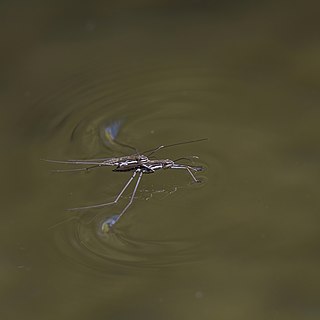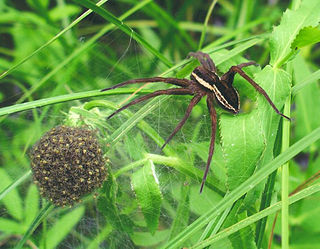
Amphizoa is a genus of aquatic beetles in the suborder Adephaga, placed in its own monogeneric family, Amphizoidae. There are five known species of Amphizoa, three in western North America and two in the eastern Palearctic. They are sometimes referred to by the common name troutstream beetles.

The Gerridae are a family of insects in the order Hemiptera, commonly known as water striders, water skeeters, water scooters, water bugs, pond skaters, water skippers, water gliders, water skimmers or puddle flies. Consistent with the classification of the Gerridae as true bugs, gerrids have mouthparts evolved for piercing and sucking, and distinguish themselves by having the unusual ability to walk on water, making them pleuston (surface-living) animals. They are anatomically built to transfer their weight to be able to run on top of the water's surface. As a result, one could likely find water striders present in any pond, river, or lake. Over 1,700 species of gerrids have been described, 10% of them being marine.

Dolomedes is a genus of large spiders of the family Pisauridae. They are also known as fishing spiders, raft spiders, dock spiders or wharf spiders. Almost all Dolomedes species are semiaquatic, with the exception of the tree-dwelling D. albineus of the southeastern United States. Many species have a striking pale stripe down each side of the body.

Veliidae is a family of gregarious predatory insects in the suborder Heteroptera. They are commonly known as riffle bugs, small water striders, or broad-shouldered water striders because the segment immediately behind the head is wider than the rest of the abdomen. The genus Rhagovelia is also referred to as a ripple bug.

The Gerromorpha comprise an infraorder of insects in the "true bug" order Hemiptera. These "typical" bugs are commonly called semiaquatic bugs or shore-inhabiting bugs. The Ochteroidea (infraorder Nepomorpha are also found in shore habitat, while the Gerromorpha are actually most often encountered running around on the water surface, being kept from sinking by surface tension and their water-repellent legs. Well-known members of the Gerromorpha are the namesake Gerridae.

Velvet water bugs are members of the family Hebridae. They are semiaquatic insects that live among moss or ponds with an abundance of vegetation, in which they prey on small arthropods. Velvet water bugs are the smallest of the Gerromorpha, and have an appearance of tiny veliids. Hebrids sometimes move across water surfaces, but walk or run rather than skate or scull on the surface.

Insects are hexapod invertebrates of the class Insecta. They are the largest group within the arthropod phylum. Insects have a chitinous exoskeleton, a three-part body, three pairs of jointed legs, compound eyes, and a pair of antennae. Their blood is not totally contained in vessels; some circulates in an open haemocoel. Insects are the most diverse group of animals, with more than a million described species; they represent more than half of all animal species.

Halobates or sea skaters are a genus with over 40 species of water striders. Most Halobates species are coastal and typically found in sheltered marine habitats, but five live on the surface of the open ocean and only occur near the coast when storms blow them ashore. These are the only known truly oceanic, offshore insects. They are found in tropical and subtropical marine habitats around the world, with a single species recorded in rivers a few kilometers upstream from the ocean. Halobates are generally very common.

Gerris lacustris, commonly known as the common pond skater or common water strider, is a species of water strider, found across Europe.

Velia caprai, known as the water cricket, is a species of aquatic bug found in Europe. It grows to a length of 8.5 mm (0.33 in) and is stouter than pond skaters of the family Gerridae. It is distasteful to predatory fish, engages in kleptoparasitism, and can travel at twice its normal speed by spitting on the water surface.

Microvelia is a genus of aquatic bugs in the family Veliidae. There are at least 230 described species in Microvelia.

Gerroidea is a superfamily of semiaquatic bugs in the order Hemiptera. There are at least 3 families and more than 2,000 described species in Gerroidea.
Rhagovelia choreutes is a species in the infraorder Gerromorpha, in the order Hemiptera . The distribution range of Rhagovelia choreutes includes Central America and North America.

Rhagovelia obesa is a species of smaller water striders in the family Veliidae. It is found in North America.
Rhagovelia rivale is a species of smaller water strider in the family Veliidae. It is found in North America.
Rhagovelia plumbea is a species of smaller water strider in the family Veliidae. It is found in the Caribbean, Central America, North America, and South America.

Rhagovelia distincta is a species of smaller water strider in the family Veliidae. It is found in Central America and North America.
Platyvelia brachialis is a species of smaller water strider in the family Veliidae. It is found in the Caribbean, Central America, North America, and South America.
Platyvelia is a genus of smaller water striders in the family Veliidae. There are about nine described species in Platyvelia.

Microvelia macgregori is a species of true bug in the family Veliidae. It is semi-aquatic, living on the surface of water in freshwater habitats in New Zealand.














